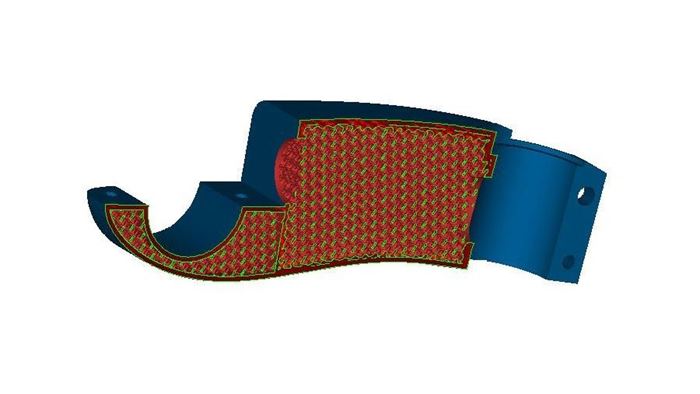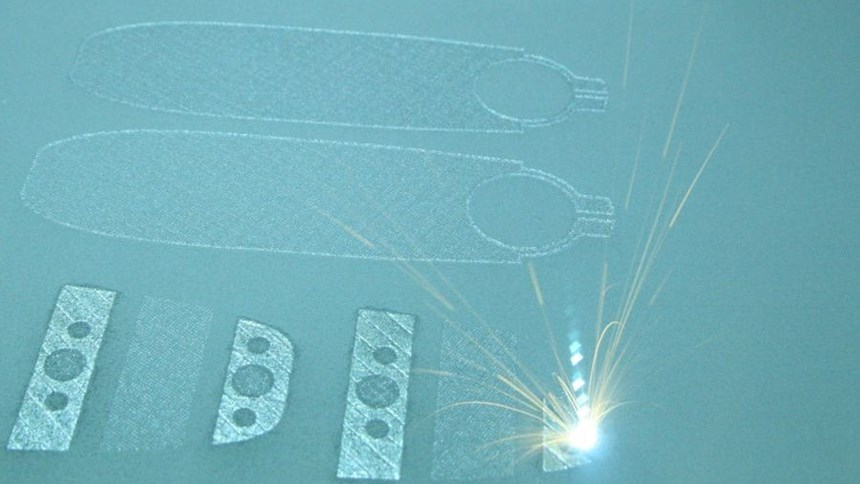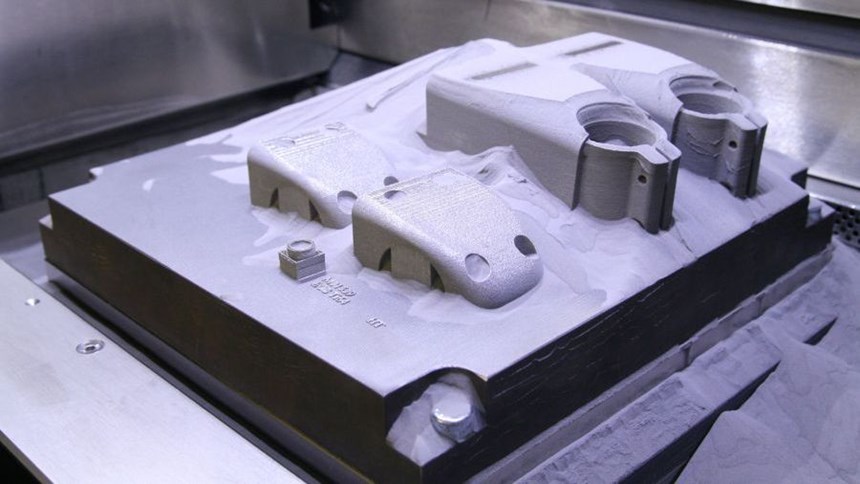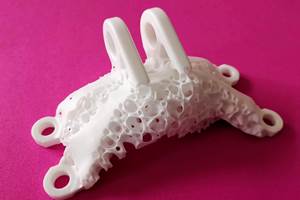Lattice Generation Software Advances Bike Component Design
A U.K. research project redesigned a bike stem with an internal lattice to reduce the amount of material needed while maintaining strength.
Additive manufacturing can place material exactly where it is needed, enabling the creation of parts that are lighter but just as strong as their conventionally machined counterparts. But in order to strike the right balance between weight and strength, design changes are necessary. Research conducted under the umbrella of the U.K.-based SAVING Project explored ways of reducing material usage via additive manufacturing. One project to redesign a bike stem relied on an internal lattice structure to reduce the amount of material needed to create a strong, functional bike component.
The SAVING Project (which stands for Sustainable product development via design optimization and AdditiVe manufacturING) consortium was established in September 2009 and was funded by the U.K.’s Technology Strategy Board (now known as Innovate UK). Partners included the University of Exeter; rapid prototyping firm Plunkett Associates; additive manufacturers 3T RPD and RaceWare Components (an AM venture started by a 3T RPD employee); software developers Delcam and Simpleware; and AM equipment manufacturer EOS. With the tagline “Making more with less,” the project’s goal was to improve sustainability and reduce energy consumption, both in production and end-use products, through strategies like lightweighting and material reduction.
Smart Aero Technology, a research and design group that specializes in cycling aerodynamics, approached the SAVING Project in 2012 about developing a bike stem that would be easier to produce in various sizes and superior in performance to those on the market. The stem connects the handlebars to the steerer tube, and its strength and stiffness affects the bike’s handling. A stiffer stem means better power transfer and momentum. Weight and aerodynamics are also important considerations; the lighter and more aerodynamic the stem, the faster the bike can be.
The project collaborators worked from an existing bike stem designed and produced by Smart Aero in carbon fiber. A challenge with this stem is that many tools are required to produce the range of lengths and angles offered, making production costly. In building the stem additively, the SAVING Project hoped to reduce the cost of manufacturing the bike stem and improve its aerodynamic performance while maintaining strength.
Consortium member 3T RPD took the lead on the project. After several brainstorming sessions, the company determined that the project’s goals for the bike stem could be achieved with a two-part design strategy:
- A reduced external wall thickness that would reduce weight and optimize air flow, and
- An internal lattice structure that would further reduce weight while providing strength and support for the stem’s outer skin during building.
3T RPD turned to project partner Simpleware for the creation of the internal lattice. Simpleware is the developer of ScanIP, a software program for processing 3D image data that is capable of generating STL files for 3D printing. When equipped with the Simpleware +CAD module, the program can generate lattice patterns to fill volumes of a model destined for additive manufacturing. This capability helps to speed up the design process and is used for lightweighting applications in aerospace and automotive industries. An added benefit is that the resulting part design is highly scalable, so that future parts of similar shape could be built at little extra development cost.
The lattices created via Simpleware’s software consist of repeating cellular units available in various designs. Though the unit designs are generic (custom designs can also be loaded to the software), the freedom to adjust the size of the cell and the volume fraction of the fill permits a range of variation. The software automates the creation of the lattices, but does not select these variables; instead, the designer selects the pattern, cell size and volume fraction combination.
For the bike stem project, 3T RPD and Simpleware worked from CAD data for the existing Smart Aero bike stem. Finite element analysis (FEA) was conducted in SolidWorks to help determine the best shape, size and density of the internal lattice based on the bike stem’s external envelope, physical loads and constraints. Titanium was chosen as the build material because of its high strength-to-weight ratio.
Nylon prototypes of the bike stem were built at 3T RPD on an EOS P machine, a selective laser sintering (SLS) system. Finally, test parts were built in titanium using an EOS M direct metal laser sintering (DMLS) machine. Following the build, supports were removed from the metal bike stem using a wire EDM, and a micromachining process was used to polish the part to a mirror-like surface finish.
The DMLS bike stem was then tested to determine its usability. While the stem performed well, it was ultimately found to be too stiff for most riders’ needs because of the small cell size and high volume fill. While stiffness is a desirable quality in a bike component, too much makes for bumpy ride. Some flex is necessary for the comfort of the rider. Additionally, the stem remained expensive to manufacture—according to 3T RPD, the component would have cost around 3,000 pounds (nearly $4,500) on the market. Approximately one-third of this cost would have gone toward the micromachining process (MMP) polishing to smooth the surface of the rough DMLS part.
While the project did not directly result in a bike stem available for sale, technologies and strategies used in the SAVING Project are being applied to new bike components produced by the team of 3T RPD, RaceWare Components and Smart Aero Technology. By adjusting parameters on the SAVINGS Project bike stem and opting for a more traditional finish, Raceware has been able to additively manufacture bike stems that currently retail for less than 1,000 pounds.
Related Content
Spherene Creates Metamaterial with Geometry Derived from Spheres
An algorithm developed by Spherene Inc. generates Adaptive Density Minimal Surfaces (ADMS) as a self-supporting infill strategy that can be used to reduce mass and manage material properties in 3D printed parts.
Read MoreImplicit Modeling for Additive Manufacturing
Some software tools now use this modeling strategy as opposed to explicit methods of representing geometry. Here’s how it works, and why it matters for additive manufacturing.
Read More3MF File Format for Additive Manufacturing: More Than Geometry
The file format offers a less data-intensive way of recording part geometry, as well as details about build preparation, material, process and more.
Read More7 Things We Saw at Formnext 2024 — Video Playlist
There were countless processes, applications and announcements at Formnext 2024. Here are seven standouts Peter Zelinski and Stephanie Hendrixson caught on film.
Read MoreRead Next
3D Printed Polymer EOAT Increases Safety of Cobots
Contract manufacturer Anubis 3D applies polymer 3D printing processes to manufacture cobot tooling that is lightweight, smooth and safer for human interaction.
Read MoreProfilometry-Based Indentation Plastometry (PIP) as an Alternative to Standard Tensile Testing
UK-based Plastometrex offers a benchtop testing device utilizing PIP to quickly and easily analyze the yield strength, tensile strength and uniform elongation of samples and even printed parts. The solution is particularly useful for additive manufacturing.
Read MoreAlquist 3D Looks Toward a Carbon-Sequestering Future with 3D Printed Infrastructure
The Colorado startup aims to reduce the carbon footprint of new buildings, homes and city infrastructure with robotic 3D printing and a specialized geopolymer material.
Read More
.jpg;width=70;height=70;mode=crop)























